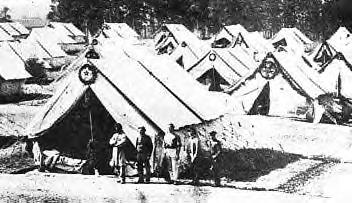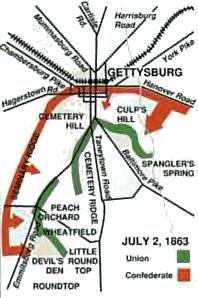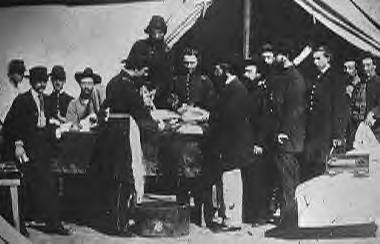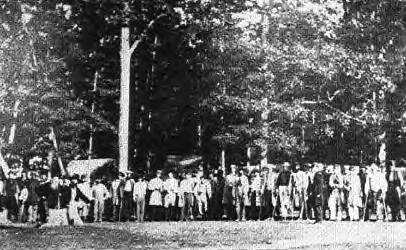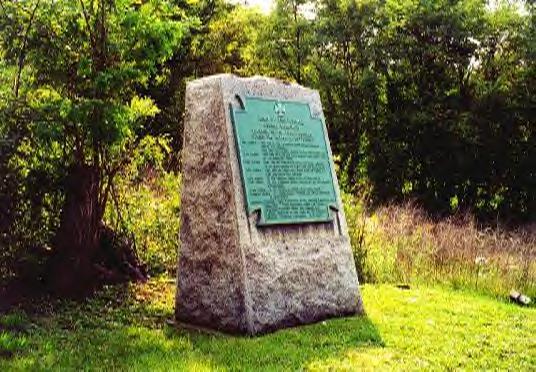|
Lee's Retreat First Shot Sach's Covered Bridge Penelope East Calvary Amos Humiston East Calvary Field Menchey's Spring Bullet Damage Hospitals The Peach Orchard The "Bloody" Wheatfield The National Tower Culp's Hill Eternal Light Peace Memorial Reynold's Woods Benner's Hill Pickett's Charge National Cemetery and Evergreen Cemetery Battle in the Town McPherson's Ridge Railroad Cut 
Homes on the Battlefield  Re-enactors
Re-enactors
Credits Links Lodging 61st Pa Ghost's of Gettysburg Mailing List Store Other Battles of The Civil War |
At the close of the battle, approximately 28,000 wounded soldiers of both armies required medical treatment. Some of the more fortunate with minor wounds were able to be treated and quickly removed from the area though more serious wounded could not be moved. Temporary "field hospitals" were established wherever there was a source of water and shelter and every building was fair game: churches, farm buildings, private homes, and barns. For some, the only shelter available was provided by trees or a piece of canvas strung between poles. Wounded were everywhere, including a number of southern wounded left behind when the Confederates retreated. Lee's Medical Department attempted to transport many of their wounded back to Virginia though their suffering was terrible. Miles of wagons overloaded with wounded men bumped and jolted over muddy roads toward the Potomac, each bump causing more misery than can be imagined. Wounded southerners left behind may have been more fortunate. They fell into Union hands and were treated with equal care by Union surgeons already overworked by the vast amount of Union wounded. The hardships of the injured were only matched by the exhaustion of overworked doctors, attendants, and ambulance drivers. Regimental surgeons began the grisly task of sorting and treating the wounded while the battle raged. Surgical operations took place in the parlors of homes, in barns, or in the front yard of a farmer's house after which the wounded were set aside to be nursed by a handful of attendants. A steady flow of injured were treated by tireless surgeons who only took minimal rest and food during the days of the battle and the weeks that followed. Medical supplies began to run low as the battle ground to it's bloody end and the situation was close to becoming a crisis.
Treatment of the wounded left at Gettysburg was left up to the mercy of the Army of the Potomac. Dr. Johnathan Letterman, Medical Director for the Army of the Potomac, was not totally unaware of the difficulties in proper treatment of so many wounded and the difficulties his staff of doctors and regimental surgeons faced. Letterman had learned from his experiences in many difficult campaigns that proper medical care required swift action and the immediate disposal of staff, supplies and equipment within the battle area. Letterman also depended on the services of charitable organizations such as the US Christian Commission and the US Sanitary Commission to provide medical supplies and personnel to assist with temporary field hospitals and transport of the injured and maimed. As early as the first evening of the battle, Letterman had medical supplies, tents, and provisions on the way to Adams County. Dr. Letterman allowed regimental surgeons to do their work at the numerous temporary field hospitals, but knew that the hundreds of hospitals made support difficult on an already overburdened supply train. He issued orders on July 5, 1863, to establish a general hospital in the Gettysburg area and provide transportation and supplies to the site for treatment of the wounded. In his honor, the temporary hospital was named after him. The site chosen for the vast hospital camp was on the George Wolf Farm, roughly one and one-half miles east of Gettysburg on the York Pike. The farm was adjacent to the main road and the railroad where a depot was established. Arriving trains would deliver a continual flow of supplies for the Gettysburg camp and transport convalescents to permanent hospitals in Philadelphia, Baltimore and Washington. Wolf's farm had good drainage, water and a ready source of firewood. The hospital was ready by mid-July and staffed with a small army of surgeons, nurses, cooks, quartermaster and supply clerks while a detachment of infantry was detailed as camp guards to look after stores and hospitalized Confederate prisoners. A steady stream of ambulances brought injured Yanks and Rebs to the camp where each man was assigned to a bed in one of the large tents or wards. Miss Sophronia Bucklin was one of the first nurses assigned to Camp Letterman and arrived in mid-July, ten days after the camp was opened. "The hospital lay in the rear of a deep wood, in a large open field a mile and a half from Gettysburg, and overlooking it, the single file of rail which connected the battletown with the outer world... The hospital tents were set in rows, five hundred of them, seeming like great fluttering pairs of white wings, brooding peacefully over those up between these rows in order that they might dry quickly after summer rains. The ground, now sodded, soon to be hardened by many feet, was the only floor in the wards." Though Camp Letterman was primitive by modern standards, the hospital was vast and impressive. One tent had upwards of 40 folding cots with mattresses and linen sheets, a real luxury for soldiers who'd laid on the hard ground or in hay lofts since being wounded. Nurses were assigned to a set of wards to bathe and feed the patients. A large cook house, built in the woods at the central heart of the camp, supplied soups, stews, and warm bread for meals. Warehouse tents were erected near the railroad to accommodate tons of supplies that arrived by railroad. A temporary morgue and cemetery were also established near the camp and deaths were quickly dealt with by a Christian burial attended to by an army chaplain. Agents and representatives of the US Sanitary Commission and US Christian Commission arrived and set up their respective headquarters at the camp. Both agencies provided services to the patients with nursing care as well as religious inspiration. Surgeons assigned to the camp worked around the clock treating the more seriously wounded while the ambulatory cases were set aside for transferral to permanent hospitals. Camp Letterman was filled to capacity by late July and eventually hosted over 1,600 patients. Hundreds more were treated by the medical staff in some of the temporary hospitals in Gettysburg churches and homes before they were emptied. Surgeons worked long hours in treating the wounded. Amputations were performed in front of a surgical tent pitched near the end of the rows of hospital tents. The surgeons were so skilled that the removal of an arm or a leg was accomplished in a matter of minutes and the unlucky soldier returned to his bed within the hour. Tools were washed with cold water and not properly sterilized, a common practice for that time. This lack of knowledge of bacteria and germs made for frightful cases of gangrene and tetanus, and infection was a major problem in the camp. Already weakened from the effects of wounds and surgery, those patients who suffered infections were also subjected to the added effects of diarrhea and dysentery. Despite the threat of infection and effects of poor diet, most of the camp's patients weathered the surgeon's knife and survived their ordeal. While army medical staff labored in the camp, members of the Sanitary Commission worked near the railway depot, assisting in the transportation of wounded bound for permanent hospitals. Transportation was limited due to the single railroad line that entered Gettysburg and it was often a long wait until the next train arrived. One volunteer for the US Sanitary Commission recorded the task of caring for the wounded: "The surgeon in charge of our camp, with his faithful dresser and attendants, looked after all their wounds, which were often in a most shocking state, particularly among the rebels. Every evening and morning they were dressed. Often the men would say, 'That feels good, I haven't had my wound so well dressed since I was hurt.' Something cool to drink is the first thing asked for after the long dusty drive, and pailfuls of tamarinds and water, 'a beautiful drink,' the men used to say, disappeared rapidly among them. .
Less than 100 patients remained at Camp Letterman by November 10 and it was officially closed a few weeks later. Tents were removed, remaining supplies taken to Washington, and the sole cook house dismantled. George Wolf returned his farm to its original purpose with only the camp graveyard remaining as a reminder of what had been established there. There had been remarkably few problems with the hospital and Dr. Letterman's goals had been met in treating and removing the wounded from Gettysburg and the surrounding farms. Camp Letterman was a role model for future military field hospitals and as The Adams Sentinel reported, "The arrangements of the Camp Hospital were so perfect and such constant and prompt attention given to the wants of the wounded, that the sufferings incident to those terrible results of war have been much ameliorated and the brave soldiers, who were the sufferers, will never forget Gettysburg."
.
What are people saying about This site! "This has got to be the greatest Gettysburg website i have ever seen!!!"William Matthews--Glassboro,NJ "Wow im impressed--Riverside,CA. "My favorite page! "Mike Torrez--Mexico
Copyright © 2001-2002,Gettysburg Battlefield Online
|
